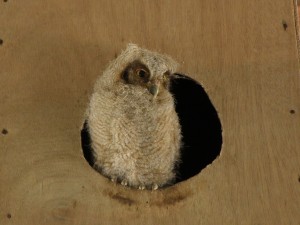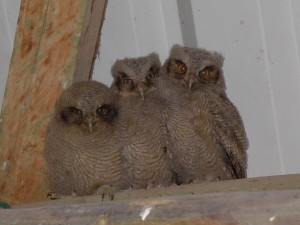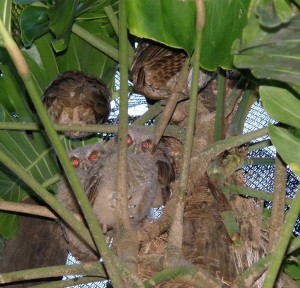Further Adventure of that Little Ball of Fluff

By Jack Ewing
About a year ago in an article entitled “A Ball of Fluff Called Equinox” I told the story of an owl called Equinox who, on March 20, 2009 was nothing more than a little ball of fluff that came walking into my office at 6:30 in the evening just as I was thinking about closing up and going home. It was obviously a very young owl, nearly ready to fledge, but not yet able to fly. We had heard an adult owl calling near the office on quite a few occasions, and I surmised that this owlet had fallen out of its nest, and that its chances of getting back were almost nil.
Normally I believe that it is best to let Mother Nature deal with her own creations. Her ways may sometimes seem harsh to us, but if a baby is separated from its mother and destined to die, nature has a good reason. I don’t feel we should interfere in this process. But this cute little ball of fluff was too much for me. I couldn’t bring myself to shoo it out of the office and into the cruel world outside. Instead, I called my wife Diane, who totally disagrees with my philosophy about survival of the fittest, and asked if she would be interested in trying to rescue a helpless owlet. “Do you have to ask?” She replied. “Bring it over.”
At first we called the owlet Equinox because it appeared on the day of the spring Equinox, but Diane later shortened the name to Iggy. In last year’s article I told of the process of raising and educating Iggy and releasing him into the wild. I also told of Iggy’s first offspring, called Junior, who fledged in July of 2011.
In addition we learned how on the evening of March 18, 2011 about 5:00 PM, at the Hacienda Barú office, I walked into the storeroom and came face to face with another ball of fluff. It was a dead ringer for Iggy when he first appeared, and practically in the same place. Vanessa, the receptionist, spotted a second ball of fluff on one of the shelves, and the following day a third one appeared. The day after that the mother owl started appearing with the fledglings in the late afternoon. It was then that everything became clear. We hadn’t really rescued Iggy at all on the equinox of 2009, rather we had kidnapped him from his mother, and taken him on a strange adventure that few owls will ever experience. The mother owl had made her nest in a secluded cubby hole in the ceiling of the office storeroom. When the chicks started to fledge was when we started noticing them on the floor, the furniture, and the shelves of the store room. One evening right at dusk we saw all three of those owlets perched in a tree outside the office with their mother. That was the last time we ever saw them.
We don’t have room in these pages to retell that whole story, but for those who would like to read it, you can find the complete tale of Iggy at www.haciendabaru.com.

In early January of 2012 another ball of fluff appeared near the office. This one was spotted by a birder who had come to the office to talk about scheduling a bird watching tour. The sight of the owlet was all it took to make up her mind for her. The next evening we saw the same ball of fluff, or perhaps another one, in the same store room where Iggy’s parents had nested for the last two years. By the end of January those fledglings had moved out into the wild.
In 2010 we had built a nesting box on the patio of our home. Junior had been hatched in that box in 2011. Judging by the strange sounds that started coming from the nesting box in late December 2011, we knew that Iggy and his/her mate, who we called Igga, had again taken up residence and were probably making a nest. By the end of January 2012 we were hoping to see fledglings. Every day Diane reminded me to check the patio for owlets when I first got up in the morning. We waited and watched. By the last week in February we had given up hope. We decided that Iggy’s nest had failed, and that that there would be no owlets this year. We imagined that the egg or eggs had been infertile, or that the recently hatched chick or chicks had gotten sick and died, or something else. We finally gave up, and quit waiting and watching.
On the morning of February 27, 2012, I was at my desk at the Hacienda Barú office when the phone rang. It was Diane who told me in an excited voice that a baby owl had appeared. By the time I got home for lunch the owlet had returned to the depths of the nesting box. That afternoon I was preparing to return to the office when I heard Diane squeal, “Jack! Come quick! The baby owl!” She had been watching television from a chair that gives her a clear view of the nesting box, had happened to glance away from the TV and saw a ball of fluff sitting in the entrance hole to the box. We named it Quigley.
Two days later at 5:00 AM, I opened the doors to the patio and almost stepped on Quigley, who was standing on the floor. I went to call Diane and returned just in the nick of time. The owlet was climbing up a wooden pillar and our big male cat, Jake, was just inches behind. Diane grabbed Jake and locked him in a travel cage. I grabbed Quigley and returned him to the safety of the nesting box. That day marked the beginning of a flurry of cat cage building at the Ewing household. Trips to the hardware store, measuring, sawing, hammering and moving our four cats from their small travel cages to their nice new living cages. Walking across our living room became like moving through a maze of cat cages. I think we bought out the entire stock of kitty litter at the Dominical Supermarket.

On March 2 Ana, the girl who helps Diane around the house, was sweeping the floor of the carport, which is on the opposite side of the house from the patio and the nesting box. She happened to glance out toward Diane’s orchid garden and saw a ball of fluff sitting in a small tree. She called to Diane to see if Quigley was still on the patio. Diane called back and assured her that he/she was sitting on a rafter. They both headed straight for the orchid garden, and there they encountered Quigley II, the ball of fluff Ana had seen sitting in the small tree. By this time the owlet was on the ground under the tree and looking forlorn. Neither of the parent birds was in sight. Diane got a pair of leather gloves and moved Quigley II all the way back to the patio, which was clear on the other side of the house and placed him/her in the nesting box. Reflecting on this later we decided that the adult owls were probably pretty upset by Diane’s move. Though she was only thinking of the owlet’s safety, the adult owls had probably worked long and hard to move Quigley II from the patio all the way around the house to the orchid garden, a distance of at least half a football field. This had probably been a big step in the owlet’s education. Now they had to start all over again.
The following morning when I got up at 5:00 AM, it was still dark out. I opened the doors to the patio and shined a flashlight around looking for owls on the floor, furniture and ceiling. To one side of the patio I spotted an owl perched on a rafter. Illuminating it with the edge of the light beam so as not to blind it, I could clearly see its adult plumage. Moving the beam of light I followed the rafters around the porch until I spotted another owl on the other side. It appeared to be a fledgling, but I moved closer to get a better look. Half way across the patio I was surprised by a blow on the top of my head. I never saw a shadow, never felt any air movement, nor did I hear a flap of wings. I only felt the blow and the searing pain of owl’s claws digging into the bald spot on my scalp. Then I saw it fly over me off the patio. Instinctively I reached up and touched painful area. There was blood on my fingers. Diane later treated the cuts and scratches with iodine. She counted 17 separate wounds, most of which were only surface scratches, but four or five were substantial and required treatment for about a week. Apparently the adult owl had clenched its claws on my head a couple of times, but only got me good once. One wound was considerably wider and deeper than the others, and Diane thinks it may have been from the owl’s beak. The message was clear. “Don’t mess with Iggy’s kids.”
Then, to our utter astonishment, on March 5 Quigley III appeared. All three siblings were on the patio sitting together on a rafter.
After that Ana, who we had begun calling “Eagle Eye,” got in the habit of carrying out a thorough search of the house and garden every day. On March 7 she found the two adults out in the orchid garden. During the final stages of Iggy’s liberation three years earlier Diane had built a box in the orchid garden, which served as a shelter and a place to give Iggy occasional scraps of meat. The box was still there and Iggy and mate were perched in a philodendron plant that was growing on the pole where that box was mounted. The three owlets were still on the patio, clear on the opposite side of the house about 60 meters (197 feet) from the parent birds.
On March 9 I got up as usual at 5:00 AM, and went about my morning routine. There were two owlets on the patio, but no adults. Though it was still dark, I walked out to the carport on the other side of the house near the orchid garden. As I entered the carport I heard a clicking sound like owls make with their beaks, and my foot nudged something soft. Shining my light down I was startled to see an owlet standing on the floor, clicking its beak, and flaring its wings in a threat display. It was mostly fluff, but the wings were lined with flight feathers. I surmised that it could manage clumsy flight, but probably couldn’t take off from the ground. I bent over and picked it up from behind so that it couldn’t bite or scratch me and started carrying it to a small tree just at the edge of the light from the carport. Approaching the tree I looked up to my second surprise of the morning. Less than two meters (six feet) away was an adult owl staring at me with a menacing glare. My heart skipped a beat. I lowered my head to avoid an attack on my eyes and quickly placed the owlet on a branch. Glancing up I noted that the adult was no longer where it had been. I turned and started walking toward the house, relieved to have avoided an attack. About ten meters from the tree I felt the blow, again on my bald spot, and knew immediately what it was. This attack left only minor scratches.
It turned out that Iggy and Igga were in the process of moving the Quigleys away from the nesting box and the patio and around the house to the orchid garden, apparently as the next step in their education. Later in the same day of the second attack Ana found three owls in the philodendron, both adults and the owlet I had helped that morning. For the next couple of nights we could hear the adults visiting the two owlets that had remained on the patio, apparently taking them food. Occasionally one of the adults would enter the house to catch a cricket or cicada. On March 13 there were two adults and two owlets in the philodendron and one owlet on the patio. The next day all five owls were in the garden, Iggy and Igga and all three Quigleys.
From that day until this writing on April 14, 2012, we have occasionally heard owls on the patio at night, hunting and calling. We have heard both mature owl calls and adolescent calls. For a couple of weeks all five owls could be found in the philodendron during the day. After two attacks I had learned not to get too close to them during the hours of darkness. Obviously Iggy and Igga were teaching the Quigleys to fend for themselves.
On March 29 there were only three of them, one adult and two owlets. After that on some days there were three and on others four, but never five. On April 14 there were only two, one owl and one owlet and on the next day there were two and two. I suspect that the adults will take the Quigleys out one at a time and put them through the ritual of cutting the apron strings. This will probably take some time, and only they know the details of the process. I feel privileged to have been able to observe a small part of the Tropical Screech Owl family dynamics.
That is what I love about working with ecotourism, bird watching and nature in general. You never learn all of the answers. The more you learn the more you want to know.

